




[If you do not see a blue menu bar on the right, click here. You are at "Penile Anatomy - Intact and Circumcised".]





[If you do not see a blue menu bar on the right, click here. You are at "Penile Anatomy - Intact and Circumcised".]
The first thing one needs to understand about the penis is that from birth, the foreskin is sealed down to the head. This is because in utero, both form as one structure. Over time, this becomes two separate structures, allowing the foreskin to become retractable. This can take up to the teen years to be complete. This is why one should never attempt to retract the foreskin of a child.
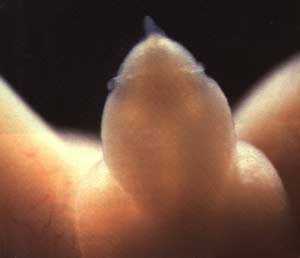 A developing fetus in the womb. Both sexes are identical until about the 10th week gestation. |
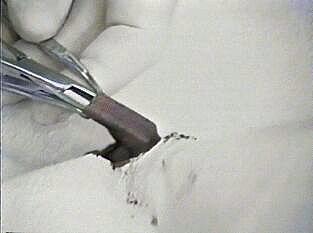 One of the first steps of a circumcision is to forcibly separate the foreskin from the penile head (also called glans or glans penis). |
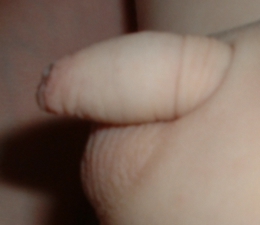 A non-circumcised 15-month-old baby. |
 A newly-circumcised infant. |
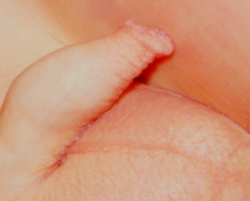 A 9-year-old boy prior to being circumcised. |
 The same child having just been circumcised with the plastibell method. |
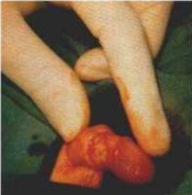
 1895: "In all cases of masturbation circumcision is undoubtedly the physician's closest friend and ally... To obtain the best results one must cut away enough skin and mucous membrane to rather put it on the stretch when erections come later. There must be no play in the skin after the wound has thoroughly healed, but it must fit tightly over the penis, for should there be any play the patient will be found to readily resume his practice, not begrudging the time and extra energy required to produce the orgasm. It is true, however, that the longer it takes to have an orgasm, the less frequently it will be attempted, consequently the greater the benefit gained... The younger the patient operated upon the more pronounced the benefit, though occasionally we find patients who were circumcised before puberty that require a resection of the skin, as it has grown loose and pliant after that epoch."
1895: "In all cases of masturbation circumcision is undoubtedly the physician's closest friend and ally... To obtain the best results one must cut away enough skin and mucous membrane to rather put it on the stretch when erections come later. There must be no play in the skin after the wound has thoroughly healed, but it must fit tightly over the penis, for should there be any play the patient will be found to readily resume his practice, not begrudging the time and extra energy required to produce the orgasm. It is true, however, that the longer it takes to have an orgasm, the less frequently it will be attempted, consequently the greater the benefit gained... The younger the patient operated upon the more pronounced the benefit, though occasionally we find patients who were circumcised before puberty that require a resection of the skin, as it has grown loose and pliant after that epoch."
E.J.Spratling, Masturbation in the Adult, Medical Record, vol. 24. (1895): pp. 442-443.
During erection, the penis grows both longer and wider. The foreskin provides the needed "extra" skin. Actually, the foreskin is not "extra" skin, at all, but a continuation of the shaft skin. It folds under itself near the end of the glans, so that it is twice as "long" as it appears (and in doing so, the sensitive inner foreskin is protected by the outer foreskin). In this way, it makes up on average 50% of the total skin of the penis.
 "I, as an anatomist and a neuroanatomist can tell you that that foreskin is very highly innovated. And, when separated,that is a serious injury!" --Ashley Montagu, Ph.D, Anthropologist (1995)
"I, as an anatomist and a neuroanatomist can tell you that that foreskin is very highly innovated. And, when separated,that is a serious injury!" --Ashley Montagu, Ph.D, Anthropologist (1995)
During an erection, the foreskin unfolds -or "unwrinkles"-
back from the glans, providing the skin for the enlarged penis, without any tearing or
stretching. What is termed "the outer foreskin" moves farther back on the shaft, and the
"inner foreskin" is now "on top" of the penis. The inner foreskin, like the underside of the
eyelid, or inside of the cheek, is a mucous membrane. Note that this is not affected by the foreskin being sealed to the glans in young boys.
For illustrations and further explaination of the anatomy and mechanics of the natural penis, see Anatomy and Intact Anatomy. You can also see several photographs depicting the variance in penile appearance at this site. See also the color photos illustrating The Three Zones of Penile Skin: - Shaft skin, the foreskin's outside fold, and the foreskins inside fold.
 "Well.....I went to the doctor in November because I was
experiencing pain during and after sex due to my foreskin being tight. He
suggested getting circ'd so I did. Now that is has been done....it seems that he
took an excessive amount of skin in which I personally think wasn't necessary. It
seems like he took alot of the skin from the shaft of my penis and then stretched the skin from the base of the penis to connect at the bottom of the head. Now when I get hard it's pretty tight and actually it's pissing me off because the skin from the base of my penis is now my penis and it has hair on it. It also isn't as long as it was before. Is there anything that can be done about this? I'm thinking about going back to the same doctor and finding out if there is anything that can be done because this is not right. Please advise." --David (7/2000)
"Well.....I went to the doctor in November because I was
experiencing pain during and after sex due to my foreskin being tight. He
suggested getting circ'd so I did. Now that is has been done....it seems that he
took an excessive amount of skin in which I personally think wasn't necessary. It
seems like he took alot of the skin from the shaft of my penis and then stretched the skin from the base of the penis to connect at the bottom of the head. Now when I get hard it's pretty tight and actually it's pissing me off because the skin from the base of my penis is now my penis and it has hair on it. It also isn't as long as it was before. Is there anything that can be done about this? I'm thinking about going back to the same doctor and finding out if there is anything that can be done because this is not right. Please advise." --David (7/2000)
The lack of movement of
the circumcised penis's skin also is a cause of "friction" during intercourse; this is partly due
to the lack of mobility, but also to the lack of lubrication on the man's part-- part of the job of
smegma.(See The Issues: Hygiene in the blue menu bar for more information on smegma.) Think of the wide variety of "personal lubricants" available today at any drug store or
supermarket. Some say that these lubricants actually just add to the friction by heating up! When dryness occurs, the woman is blamed. Part of this may be due to being post-partum or menopausal when her hormones are at very low levels. Many factors play into her level of lubrication, including arrousal and the time in her cycle as ovulation induces copious amounts of thick, slippery mucous to be created by the cervix. In fact, the entire skin of the intact penis is double-layered. There is no mark of "foreskin" at the head of the glans, as is sometimes thought. For the man, this provides the rolling-action during intercourse or masturbation; for the woman, it makes sex "softer" - sort of "padded" in a way. The entire skin of the penis moves back and forth, or can be held immobile, if desired. See the video page, marked "Video About Penile Anatomy" near the bottom of the page for a short, detailed video, for more information.
During sexual intercourse or masturbation,the foreskin rolls back from the head during the "in" thrust and then forward again over
the head of the penis during the "out" thrust, rolling over and covering it, often times
completely. It does not remain behind the glans; however, some men can maintain complete coverage of the glans while erect.This rolling
action is pleasurable for both the man and the woman.
 "The foreskin does not remain behind the glans during intercourse... it is
a moveable sheath that moves back and forth to reduce friction for the female and provide sensual sensations for the male. It just
doesn't feel good any other way! Sure, some people are satisfied, but if that's all they have ever known then they have
nothing to compare it with - a common problem with educating parents about not circumcising their newborn sons. [They say,] 'My husband
loves sex. He can't imagine being anymore sensitive. We have no problems in our sex life because of my husband's circumcision...etc.'."-- Suzanne Cook, mother of 6 and wife to a non-circumcised man.
"The foreskin does not remain behind the glans during intercourse... it is
a moveable sheath that moves back and forth to reduce friction for the female and provide sensual sensations for the male. It just
doesn't feel good any other way! Sure, some people are satisfied, but if that's all they have ever known then they have
nothing to compare it with - a common problem with educating parents about not circumcising their newborn sons. [They say,] 'My husband
loves sex. He can't imagine being anymore sensitive. We have no problems in our sex life because of my husband's circumcision...etc.'."-- Suzanne Cook, mother of 6 and wife to a non-circumcised man.
For the man, the double stimulation
from the rolling and from the "pressure" of the vaginal walls brings a new "dimension" to
sex. A man wrote me several years ago comparing circumcised sex to a scoop of vanilla ice cream, and sex with his foreskin to a hot-fudge sundae. Another wrote me to say that the two are comparable to driving your basic flat, straight highway and driving through the countryside over hills and valleys and around curves with picturesque scenery along the way.
Notice the bloody appearance of the glans in 2nd picture just above; this is midway through a Gomco circumcision, after the foreskin has been torn off the head and laid back (but not yet cut off). (The first photo is just as the circumcision is about to begin.) As the circumcision site heals, a yellow crust forms on the glans and the head "thickens". This process is called metaplasia - the changing of one cell type to another. (Sometimes it is also called "re-epithelization", or re-skinning.) This thickening continues
to grow slowly throughout a man's life, much like a callous. This is why sensitivity is decreased in circumcised men. Intact men report that it is actually almost painful to have their glans touched directly. (Women may agree, as the clitoris is the female counterpart, and can have its "foreskin"- the clitoral hood- retracted also.) This loss of sensitivity not new news. Freeland and Mark reported this as a benefit of circumcision in 1900, when it was used to dull the penis, thereby hopefully reducing the rate of masturbation.
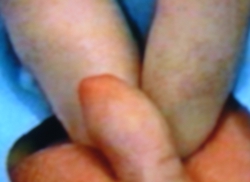
 There are other differences between the intact and the circumcised penis as well. The
head of the natural penis is a shiny, pinkish/purple color because it is an internal part of the body and is protected by the foreskin. Immediately after being circumcised, the raw glans must begin the healing process. The penis has literally been skinned of 1/3 to 1/2 of its skin.
There are other differences between the intact and the circumcised penis as well. The
head of the natural penis is a shiny, pinkish/purple color because it is an internal part of the body and is protected by the foreskin. Immediately after being circumcised, the raw glans must begin the healing process. The penis has literally been skinned of 1/3 to 1/2 of its skin. "It has been urged as an argument against the universal adoption of circumcision that the removal of the protective covering of the glans tends to dull the sensitivity of that exquisitly sensitive structure and thereby diminishes sexual appetite and the pleasurable effects of coitus. Granted that this be true, my answer is that, whatever may have been the
case in days gone by, sensuality in our time needs neither whip nor spur, but would be all the better for a little more
judicious use of curb and bearing-rein." --E. Harding Freeland, Circumcision as a Preventative of Syphilis and Other Disorders, The Lancet, vol. 2 (29 Dec.1900): pp.1869-1871.
"It has been urged as an argument against the universal adoption of circumcision that the removal of the protective covering of the glans tends to dull the sensitivity of that exquisitly sensitive structure and thereby diminishes sexual appetite and the pleasurable effects of coitus. Granted that this be true, my answer is that, whatever may have been the
case in days gone by, sensuality in our time needs neither whip nor spur, but would be all the better for a little more
judicious use of curb and bearing-rein." --E. Harding Freeland, Circumcision as a Preventative of Syphilis and Other Disorders, The Lancet, vol. 2 (29 Dec.1900): pp.1869-1871.
A 1996 report of Infectious Urology is quoted as saying "Also,
the uncircumcised penis does not have a thick stratum corneum layer of the
glans, which develops after circumcision; this layer protects against
abrasion." [Staiman VR, Kwan DJ, Lowe FC: Genitourinary Manifestations of AIDS. Infect
Urol 9(3):73-78,92, 1996.] Interesting that this is admitted, as this is precicely what Freeland and Mark said about 100 years ago - when the vast majority of men were not circumcised - deminishes sexual sensitivity, yet current publications - when the vast majority of (adult) men in the United States are circumcised - are saying this callousness "protects" the glans.
 "Not long after the operation I had not been exposed to abrasion and air too long. There was and is still some skin mobility on the shaft, so it's not so 'ram-like' as others cut tighter, yet soon I began to notice the differences. Sexually, I lost an estimated 80% of the sensation in my glans. Now, the only areas I feel much are the remnant frenulum and the so-called 'inner foreskin,' which is mucousal tissue between the circumcision scar and the glans. Instead of feeling a differentiated sense of touch, I feel only pressure. This is similar to the difference between intercourse with and without a condom, except it's amplified dozens of times now. I'd say it's probably akin to wearing five condoms at once. This loss of sensation has been compared to seeing black and white versus exquisite color. There is no longer any potential for anything that can be called 'exquisite' sex. I also KNOW I am a less senstive lover. I can't feel as much. Vaginal sex bores me and I am nearly exclusively interested in oral sex, which is marginally better." --A 31-year-old man, who was circumcised at age 28, as "some 'marking,' a blood sacrifice to symbolize the end of the torment of my marriage and welcome a new beginning".
"Not long after the operation I had not been exposed to abrasion and air too long. There was and is still some skin mobility on the shaft, so it's not so 'ram-like' as others cut tighter, yet soon I began to notice the differences. Sexually, I lost an estimated 80% of the sensation in my glans. Now, the only areas I feel much are the remnant frenulum and the so-called 'inner foreskin,' which is mucousal tissue between the circumcision scar and the glans. Instead of feeling a differentiated sense of touch, I feel only pressure. This is similar to the difference between intercourse with and without a condom, except it's amplified dozens of times now. I'd say it's probably akin to wearing five condoms at once. This loss of sensation has been compared to seeing black and white versus exquisite color. There is no longer any potential for anything that can be called 'exquisite' sex. I also KNOW I am a less senstive lover. I can't feel as much. Vaginal sex bores me and I am nearly exclusively interested in oral sex, which is marginally better." --A 31-year-old man, who was circumcised at age 28, as "some 'marking,' a blood sacrifice to symbolize the end of the torment of my marriage and welcome a new beginning".